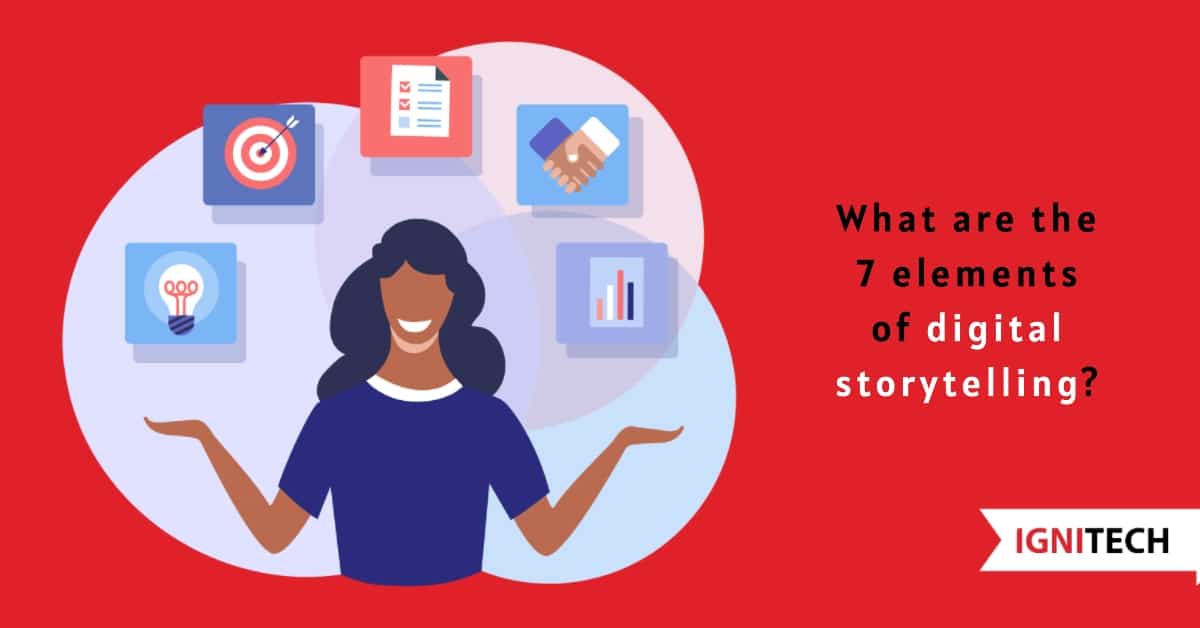Digital storytelling is the art of using digital media and technology to craft and share compelling stories. Mastering visual storytelling techniques is more important than ever for effectively connecting with modern audiences.
Whether you want to improve your content marketing, engage students in the classroom, or simply share your ideas creatively, digital storytelling allows you to combine the timeless art of narrative with modern multimedia.
In this article, we break down five powerful digital storytelling strategies to help you craft visually dynamic stories that captivate audiences and drive results. We’ll also answer common FAQs to help you on your storytelling journey.
Table of Contents
5 Powerful Strategies to Help You Excel at Digital Storytelling:

Focus on Narrative Flow
The foundation of impactful digital storytelling is an engaging narrative flow. While visuals are key, they must support (not replace) a compelling storyline. To excel:
Start by outlining the narrative arc. Identify key plot points that build intrigue and interest. Ensure your story has a clear beginning, middle, and end.
Make strategic use of storytelling techniques like conflict, repetition, callbacks, motifs and more to emphasis important ideas and create connections.
Layer in multimedia like images, audio, video, and graphics to complement the flow of the narrative itself. Don’t let flashy visuals overtake storyline.
With a sharp narrative flow as your guide, purposefully layer in visual elements to accentuate the storyline in stylistic ways that uniquely suit your brand or platform.
Focus Visuals Around Key Moments
Strategically using visuals in digital storytelling is an artform itself. The most compelling digital stories use visuals intentionally to:
- Introduce key characters or settings e.g. showing a character portrait
- Build tension and interest e.g. zooming in on a worried face
- Reinforce emotional peaks e.g. panning wide to showcase reactions
- Transition between scenes e.g. fading to black
Rather than sporadically placing random graphics and images, thoughtfully identify key story moments and points of tension. Then, zoom, pan and transition purposefully using visuals to accentuate the experience.
This technique is powerfully leveraged in digital mediums like video, slide decks, social posts, and beyond.
Keep Your Audience at the Heart
At its core, storytelling is about making emotional connections. To excel at digital narratives, you must keep your target audience at the heart of each creative choice.
Identify core audience hopes, fears and values. Get to know their worldview intimately so you can craft relatable stories.
Use visuals and concepts the audience already connects with this might include nostalgic elements, shared cultural touchpoints, or familiar themes. This establishes common ground.
Shape your narrative to resolve audience tensions. Identify pain points and craft stories that provide hope, meaning or catharsis around those issues.
By aligning each creative choice with your audience’s perspective, you transform passive viewers into engaged participants that feel a personal connection to each story you share.
Try New Creative Risks
Digital media provides awesome flexibility to take storytelling in bold new directions. Take creative risks to produce truly novel narratives that pop. Consider blending multiple formats like:
- Mixing photography, video clips, infographics and text to create engaging social posts
- Producing “slideumentaries” that use PowerPoint to share documentary-style stories
- Creating interactive stories or games that audiences navigate at their own pace
Don’t be afraid to leverage the unique functionality of websites, apps and software either. Experiment with things like parallax scrolling, embedded multimedia, hover effects and more to craft unconventional digital experiences.
Pushing creative boundaries helps your brand standout while expanding the artistic possibilities of the digital storytelling medium itself.
Consistently Hone Your Craft
Just like any artform, excellent digital storytelling requires consistency, effort and perpetual improvement to hone your creative skills over time. Make improvement a habit by:
- Practicing regularly to refine narrative flow, understand audience perspective, polish editing skills and more
- Continually learning about multimedia tools, editing software, animation techniques and modern best practices
- Using data and feedback to objectively assess the impact of creative choices and fine tune approaches
Commit to incrementally honing elements like visual composition, coherent messaging, compelling characters and efficient narrative flow across all projects and platforms.
While innate talent helps, dedication to mastering the fundamentals and improving over time is what sets truly great digital storytellers apart.
What are the 7 elements of digital storytelling?

1. Establishing a Point of View
Every storyteller brings a unique blend of background, experiences, beliefs and personality to their work. Excellent digital narratives reflect a distinct point of view instead of a generic telling.
Ask yourself:
- What singular perspective do I bring to this story?
- Why am I specifically the best person to tell this tale?
- What personal context informs my approach?
Let your distinctive POV guide everything from framing, selected details, language choices and more. Your fingerprint should be unmistakable by the end.
2. Dramatic Question
At its core, compelling stories explore tensions around unanswered questions, unresolved conflicts or mysteries yet to uncover. Consider:
- What central drama drives the narrative forward?
- What details will you strategically reveal or obscure over time to maintain interest?
- How will you payoff built suspense to satisfy the audience by the climax?
Layering in related sub-questions throughout provides continuity while allowing your core dramatic question to evolve naturally to a credible, meaningful resolution.
3. Emotional Content
Even the most creative concept falls flat unless it establishes authentic emotional connections with audiences. Weave in relatable, vulnerable moments centered on:
- Universal hopes, dreams, struggles the audience relates to
- Genuine conflicts faced by protagonists as they pursue goals
- Organically timed peaks of achievement, loss, joy and despair
Avoid overly cloying sentimentality. Allow viewers space to layer in their own meanings and connections.
4. Pacing Of The Narrative
Pacing refers to the rhythm and flow of your unfolding story across time. Elements to consider include:
- Well-balanced scene length, sequencing and transitions
- Steadily escalating rising action towards climatic peaks
- Moments of relief allowing audiences to absorb big ideas
Experiment with pacing patterns to artfully sustain intrigue. Also, purposefully place visuals, audio cues and motion at critical moments to accent pacing peaks when relevant.
5. Use of Soundtrack
Sound innovatively expands creative palette possibilities, setting tone while subtly shaping emotions. Ask yourself:
- Do soundtrack elements match overall narrative style and genre conventions?
- Is audio thoughtfully triggering key emotional shifts vs. randomly placed?
- Would removing any tracks detrimentally impact audience experience?
Use restraint. When soundtrack elements are overbearing, they distract rather than enhance.
6. Economy Of Story Detail
Be ruthless in editing down stories to only the most potent, relevant beats. Consider:
- What singular dramatic arc holds everything else together? Remove tangents.
- Are only story details essential to character goals and conflicts included?
- Could any individual scene or sequence be removed without compromising the whole? If no, keep it.
Trim surplus content with laser focus on your core dramatic question and intended emotional impact.
7. Carefully Chosen Images
In digital storytelling, visuals bear the heavy load of communicating setting, context, characters and movement. To excel:
- Meticulously storyboard exactly what images need to advance the narrative
- Sequence images rhythmically to complement storyline pacing and peaks
- Stylistically unify visuals around color scheme, texture, medium etc.
Ask if any visuals are arbitrarily tacked on vs. integral to the audience’s story experience. Remove anything superfluous.
By mastering how these 7 foundational elements harmonize, you transform disjointed ideas into seamless, high-impact digital narratives ready to educate, delight and inspire target audiences.
The benefit of digital storytelling
Enhanced Audience Engagement and Connectivity
Digital storytelling represents a seismic shift in audience engagement capabilities compared to traditional formats. Elements driving next-level attentiveness include:
Multi-sensory appeals: Blending modalities like video, imagery, graphics, animation, sound and text immerses audiences across visual, auditory and kinesthetic channels simultaneously. This compounds attentiveness through layered inputs.
Interactive capabilities: Digital canvases afford innovating storytelling formats from branching narratives, to games, to embedded multimedia all allow audiences to actively shape experiences. This interactivity promotes alert focus.
Novelty appeals: Digital creativity pushes boundaries on how narratives unfold. Unexpected mixes of imagery, unconventional sequencing and dimensional transitions capture interest through joyful novelty.
Research on digital storytelling shows strengthened recall, clarity of messaging and depth of processing for information delivered through interactive, multi-sensory digital narratives vs traditional monologic formats.
Expanded Accessibility and Distribution
Digital environments democratize producing, publishing and promoting compelling stories by making creation/sharing exponentially more affordable, quick and simple vs traditional mediums like film, television, radio and print.
User-friendly apps put capabilities like professional-grade video editing, animation, and web publishing into anyone’s hands. Distribution across social channels or embedded on sites tapping into existing traffic accelerates potential reach from local to global.
This access allows educators, activists, marketers and entrepreneurs alike to share narratives widely without relying on external gatekeepers. Democratized digital storytelling shifts creative control directly into the hands of dedicated storycrafters.
Bringing Concepts to Life Visually
Words alone cannot always adequately capture intricate concepts, contexts or demonstrating processes. Digital tools bridge this gap through simulated visualization using:
- Photos, videos and illustrations establishing settings + character
- Infographics simplifying complex systems and flows
- Animated sequences articulating everything from molecular dynamics to choreography
Thoughtful visual communication makes material tangible rather than abstract. Audience comprehension accelerates when shown alongside told. Digital canvases uniquely free storytellers to bring any scenes and sequences imaginable to life.
Pushing Creative Boundaries
While digital storytelling builds on traditional narrative conventions, multimedia capabilities empower radically reinventing how stories unfold through elements like:
- Non-linear interactive narratives promoting self-driven exploration
- Blending artificial/virtual reality to immerse audiences imaginatively
- Generative content leveraging AI to continuously personalize experiences
This creative flexibility inspires unprecedented innovation in storytelling formats themselves alongside artistic excellence within stories. Possibilities exponentially expand in the digital frontier.
Customized Experiences
Interactive digital stories allow layered pathways through content. Audiences shape experiences through:
- Personalized content recommendations
- User-driven narrative choices altering story arcs
- Profiling used to tailor messaging per individual needs
This custom-fit approach increases perceived relevance.
Embedded Analytics
Digital environments provide rich impact analytics around:
- Attention metrics like completion rates and session depth
- Sharing behavior across social channels
- Sentiment analysis quantifying qualitative reactions
- Conversion data capturing leads, sales, donations generated
This empirical feedback precipitates data-driven iteration and creative optimization rooted in audience responses rather than guesswork.
In summary, thoughtfully crafted digital narratives fuse expanded accessibility, multi-sensory viewer immersion, visual communication, and customization to produce stories that forge profoundly deeper audience connections compared to traditional formats.
What is a good example of digital storytelling?

Here are a few impactful examples of digital storytelling done well across different contexts:
Non-Profit Advocacy Campaigns
Charity:Water has produced dozens of high quality digital stories capturing how access to clean water transforms communities. Masterful video storytelling educates audiences while expanding empathy.
Brand Marketing Content
Redbull’s stunning digital content like docuseries and extreme sport highlight reels share stories uniquely suited to their brand identity in adrenaline-surging formats.
Interactive Journalism
The New York Times iconic Snowfall multimedia piece exemplifies immersed audiences in a breaking news event through parallax scrolling, embedded media and stylistic visuals.
Video Game Narrative
Titles like “Last of Us” tell character-driven stories leveraging the interactivity of gameplay while cinematic cutscenes progress the dramatic arc much like a digital film.
Education + Training
The digital storytelling format brings historical events, scientific concepts and social issues to life in engaging ways that promote retention and clarity.
These samples demonstrate that when core narrative principles align with strategic multimedia choices, digital stories can meaningfully educate, inspire and influence audiences across nearly any context.
The unique combination of creativity and expanded access empowers impact-driven storytellers everywhere to connect with people in profound new ways. Mastering the format unlocks game-changing communications potential.
Digital Storytelling Mistakes to Avoid
Common pitfalls for novice digital storytellers also provide helpful learning opportunities, such as:
Putting visual dazzle before narrative substance: Without an engaging arc, even the most visually-sleek digital tale feels hollow. Prioritize storyline first.
Overusing intricate multimedia just because you can: Fancy visuals should match storyline weight. Use restraint with transitions and effects that subtly complement vs. distract from purpose.
Forgetting your audience’s perspective: Losing sight of viewer context/expectations risks narratives feeling generic, unrelatable or emotionally detached. Anchor creative choices in audience intimacy.
Avoiding these missteps keeps projects sharpened around core intentions vs. arbitrary creativity.
Key Takeaways and Next Steps
The key takeaways around effectively leveraging digital storytelling include:
- Digital narratives combine visual media with engaging storyline to connect with modern audiences
- Focus first on crafting a sharp narrative flow before layering in complementary visuals
- Strategically use multimedia to accentuate (not replace) key story moments
- Keep your target audience perspective at the heart of each creative choice
- Take bold creative risks and blend formats to produce something truly unique
- Hone your craft through continual practice, learning and improvement
Ready to advance your digital storytelling skills? Some simple next steps include:
- Trying new multimedia tools to expand your creative capabilities
- Producing a short video story highlighting an organization’s impact
- Weaving a personal photo narrative using parallax scrolling web design
- Crafting an interactive social campaign around a branded day or event
- Reimagining content usually shared as text into more visual formats
The possibilities are endless. Use the fundamentals in this guide combined with your unique perspective to craft digital stories that captivate audiences and drive meaningful results.
Mastering modern digital storytelling techniques is a highly valuable skill for effectively spreading ideas, building brands, and making emotional connections in the digital age.
With the right blend of visual media, narrative technique, audience perspective and continual innovation/improvement, you can craft compelling digital stories that uniquely showcase your distinct perspective while driving real results.
Compelling brand storytelling attracts high-intent audiences, humanizes products, provides endless social content, and elevates lifestyle associations that drive conversions. Strategically crafted brand narratives also increase value perception and brand loyalty across customer journeys.
Hopefully the powerful tips and strategies in this article provided helpful creative inspiration to advance your digital storytelling journey today.
FAQs
Some of the most useful tools include photo/video editing tools like Adobe Creative Suite, intuitive video creation apps like Biteable, responsive website builders to showcase stories, and social media platforms. The specific tools depend on the story format.
Use many of the core narrative strategies like establishing characters and settings, building tension through key moments, sequencing visually dynamic slides, and resolving core questions/conflicts. Avoid walls of text and let visuals enhance (not distract from) the storyline.
Digital tools allow you to leverage visuals, graphics, interactivity, multimedia and unconventional formats alongside writing and speech found in traditional narratives. This expanded creative flexibility can increase audience engagement.
Not at all! The core narrative principles underlying effective digital storytelling apply across fields like education, marketing, public awareness campaigns, design, and more. The digital format simply allows you to package stories more creatively.
Absolutely. Well-designed infographics artfully translate raw data into compelling visual narratives enhanced by relevant images, concise copy, appropriate annotations and strategic flow/layout to communicate key insights. Leveraging core storytelling principles Even in seemingly dry presentations of data is key.
Some great resources include digital storytelling hubs/online communities to get inspiration from others, courses on platforms like Udemy or LinkedIn Learning for structured guidance, and practicing regularly while incrementally trying new techniques. Don’t be afraid to imitation others’ creative formats before innovating with your own flair.
Storytelling in e-commerce involves creating a narrative around your brand or products to establish an emotional connection with customers. Utilize compelling product descriptions that go beyond features, showcase customer testimonials, and incorporate storytelling elements in marketing campaigns. Platforms like Instagram and Pinterest offer opportunities to share visual stories that resonate with your target audience, enhancing the overall shopping experience.
Yes, adopting a customer-centric storytelling approach is crucial for e-commerce success. Craft narratives that address customer pain points, highlight solutions provided by your products, and showcase real-life scenarios where your products add value. Implement a consistent and authentic storytelling tone across your website, social media, and marketing materials to build trust and encourage conversions. Keep in mind the buyer’s journey and tailor your storytelling content accordingly, from creating awareness to facilitating the decision-making process.
 Anas is our go-to copywriter with a knack for crafting persuasive and high-converting eCommerce landing pages. His passion for words and understanding of consumer psychology helps turn visitors into loyal customers. When he's not refining his copy, Anas enjoys exploring the latest digital marketing trends and experimenting with new writing techniques. His blend of creativity and strategic thinking makes him an indispensable part of our energetic team.
Anas is our go-to copywriter with a knack for crafting persuasive and high-converting eCommerce landing pages. His passion for words and understanding of consumer psychology helps turn visitors into loyal customers. When he's not refining his copy, Anas enjoys exploring the latest digital marketing trends and experimenting with new writing techniques. His blend of creativity and strategic thinking makes him an indispensable part of our energetic team.












